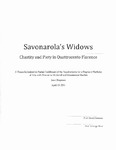Savonarola's Widows: Chastity and Piety in Quattrocento Florence (thesis)

View/
Author
Chapman, Jean Chandler Glass
Subject
Washington and Lee University -- Honors in Medieval and Renaissance Studies
Widows
Solitude
Savonarola, Girolamo, 1452-1498
Widows
Piety
Chastity -- Religious aspects
Italy -- Florence
Middle Ages
Metadata
Show full item recordDescription
Thesis; [FULL-TEXT RESTRICTED TO WASHINGTON AND LEE UNIVERSITY LOGIN] Jean Chandler Glass Chapman is a member of the Class of 2011 of Washington and Lee University. In his Book on the Life of the Widow, written in 1491, Savonarola takes into account the realities of a widow's situation, and categorizes women based upon their desires and their options. He does not condemn those who choose to marry for legitimate reasons, though he constantly promotes the ideal of the " true widow." The beauty of the state of widowhood, according to Savonarola, lies in the woman's freedom, though not her freedom to do whatever she wills or to become an independent woman within society. Rather, widows are particularly fortunate individuals, since by their husbands' deaths they have been liberated from the requirements of marriage and all the trappings of worldly life that would keep them from God. They are now free to serve God entirely. For Savonarola, this type of freedom takes the form of solitude. A widowed woman must embrace her freedom by freeing herself from the world and fully devoting herself to God -- this is the aim of the life of the "true widow." [From the Introduction] Jean Chapman
Collections
The following license files are associated with this item: